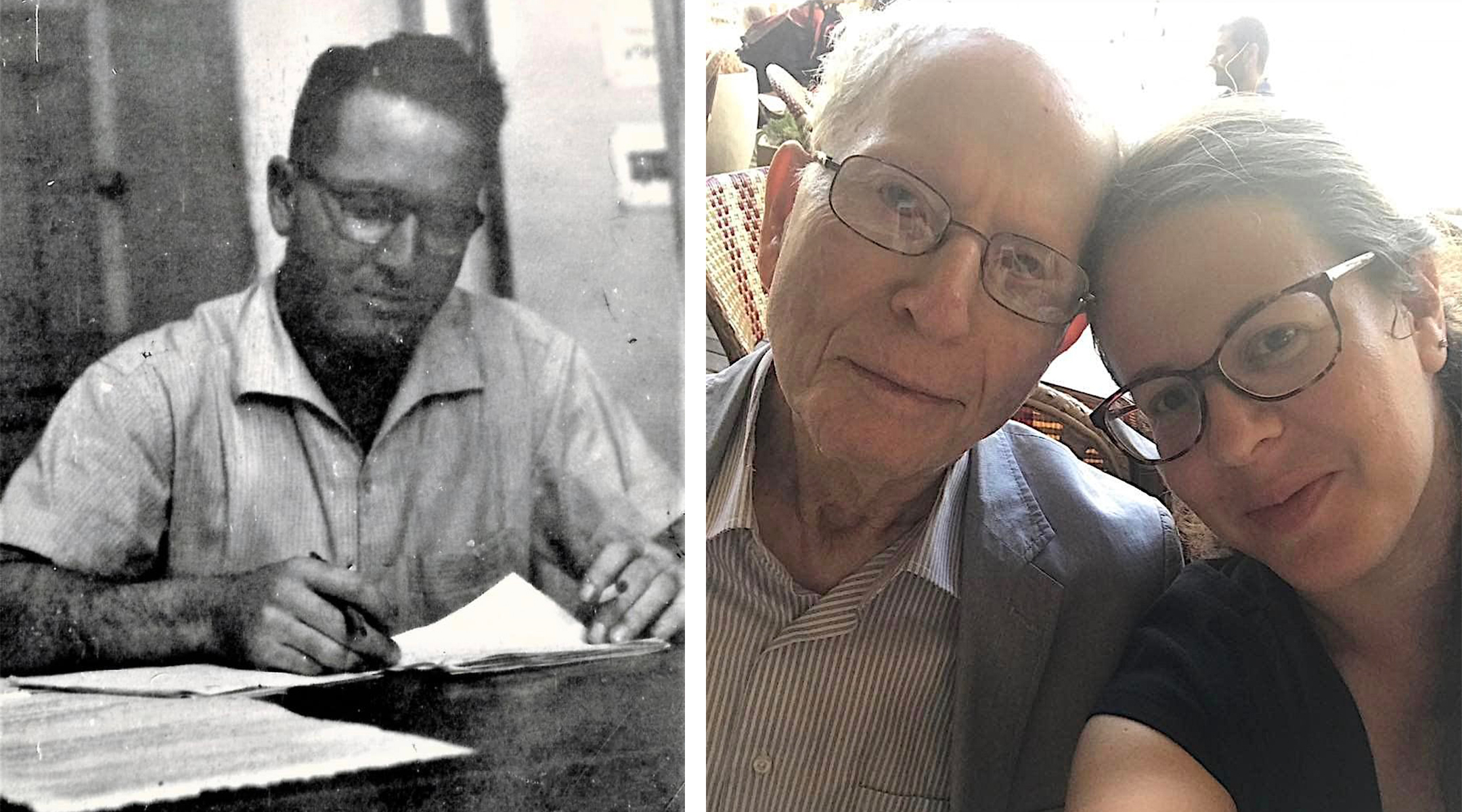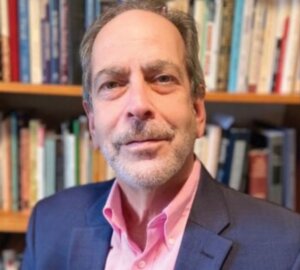Journalist and scholar Aharon Ariel, 97, veteran of Israel’s war of independence and ‘walking encyclopedia’
Ariel was a polymath who lobbied Washington when his son was held prisoner and tortured in Syria

Aharon Ariel was a Jerusalem-born scholar and journalist who fought in Israel’s War of Independence; at right, Ariel with his granddaughter Yael Ariel-Goldschmidt. (Courtesy Yael Ariel-Goldschmidt)
(JTA) — In May 1948, a decommissioned U.S. Navy ship, the Marine Carp, was carrying passengers from New York to Haifa when, stopping in Beirut, it was met by 400 Lebanese soldiers. Israel had just declared its independence and war was underway — the Lebanese had no intention of allowing Jewish men of fighting age to sail on to the nascent Jewish state.
Among the 69 passengers removed from the ship and trucked to a former French military camp in the city of Baalbek was a Jerusalem-born polymath and former Haganah fighter named Aharon Ariel. Ariel had been studying history at Columbia University and Talmud at the Jewish Theological Seminary when the war broke out and quickly rushed home.
After the U.S. government brokered the release of the prisoners in late June, Ariel was sent back to the United States and tried again to get home. Eventually, he and a number of the detainees “found creative ways to get back to Israel,” as one history of the incident puts it, and he rejoined the Israeli military.
Still in his 20s, Ariel had already seemed to embody the history of Israel — a pattern he would sustain the rest of his life as a scholar, broadcaster, encyclopedia editor, translator and father of a son who would himself become a prisoner during the Yom Kippur war. He died June 20 in Jerusalem at age 97.
“My grandfather was a true son of Jerusalem,” a granddaughter, Tamar Ariel, wrote in a tribute posted shortly after his death. “Born just outside of Jerusalem in the Palestinian Mandate in 1925, the youngest of 6, and raised on King George St., he was a scholar and lover of Hebrew, history, and Jerusalem. “
Aharon Ariel worked as a journalist whose assignments, according to his granddaughter, included the trial of Nazi war criminal Adolf Eichmann. He worked as editor of the “Encyclopedia Hebraica,” a monumental reference work issued between 1949 and 1983. His books include a historical lexicon, written with the historian Joshua Prawer in 1964, and a translation of “Annals of England” (1968) by the British historian George Macaulay Trevelyan.
The son of immigrants to Israel from Hamburg, Germany, he spoke a precise academic Hebrew and delivered a regular Hebrew lesson, “Rega shel Ivrit,” on Kol Yisrael, Israel’s main and then only radio station.
“This was before Israel had a television station, and … when it had just one radio station,” remembered another granddaughter, Yael Ariel-Goldschmidt.”I’ve never met or heard anyone speak better Hebrew. As a child I thought his job was … simply to speak Hebrew.”
In his youth he attended Ma’aleh, a religious high school in Jerusalem, where his best friend was Yehuda Amichai, who would come to be regarded as Israel’s greatest poet. At 14, he joined the Haganah, the general defense force of the pre-state Jewish community, eventually becoming a junior commander.

He studied mathematics at Hebrew University before, in 1947, he went to New York City for his graduate studies.
When the war interrupted those plans, he joined the fighting that would last until March 1949. His units suffered major casualties, including a number of his close friends.
After the war he worked as a Hebrew teacher whose students included an American immigrant named Batya (Betty) Cohen, who had been raised on New York’s Lower East Side and came to Israel as a member of Hashomer Hatzair, the socialist Zionist youth group. The two married in 1951 in the United States, where Batya had returned for graduate studies, and returned to Israel to live. Batya died in 2021.
They had three sons and nine grandchildren, one of whom predeceased them.
During the Yom Kippur war, one of those sons, Yaakov, was wounded, captured and tortured by Syrian forces. He spent nine months as a POW; because the Syrians refused to release the names of prisoners, his parents knew he was alive only after they saw a photograph of him taken by a Turkish journalist. During his captivity Aharon and Batya lobbied in Israel and the United States for his release.
“My father, with a group of other parents, went to the United States and met with anyone willing to meet them,” recalled Yaakov Ariel, now a professor of religious studies at the University of North Carolina at Chapel Hill. In addition to withholding the names of the captured, Syria refused Red Cross visits or mail. “Many parents didn’t know what was going on.”
Once again the United States brokered a prisoner exchange. Afterwards, the elder Ariel rarely talked about his own captivity in 1948 nor his son’s ordeal, according to Ariel-Goldschmidt.
“My grandparents never spoke to me about this, except for once,” she recalled. “My friend Jordana came over on Shabbat for lunch and brought her little sister, who was just young enough and bold enough to ask questions no one else asked. My grandmother took out photo albums with newspaper clippings from when my father was MIA, from when he was a POW. That is how I learned that my grandfather was elected by the parents of the POWs to fly to the U.S. and campaign on their behalf, to urge the U.S. to exert pressure on Syria and broker a prisoner exchange, which the U.S. (and [Secretary of State Henry] Kissinger) eventually did.”
Her grandfather was forthcoming on many other topics.
“He was a connoisseur of whiskey, art, pescatarian food, and coffee,” wrote Tamar Ariel. “He and my grandmother introduced me to Impressionism, taking me to art museums across Israel, the U.S., and Europe from a young age.”
He could also expound on the Hebrew Bible, the Talmud and the history of the country whose biography parallelled his own.
“My grandfather was a walking encyclopedia,” wrote Ariel-Goldschmidt.
This article originally appeared on JTA.org.
A message from our Publisher & CEO Rachel Fishman Feddersen

I hope you appreciated this article. Before you go, I’d like to ask you to please support the Forward’s award-winning, nonprofit journalism during this critical time.
We’ve set a goal to raise $260,000 by December 31. That’s an ambitious goal, but one that will give us the resources we need to invest in the high quality news, opinion, analysis and cultural coverage that isn’t available anywhere else.
If you feel inspired to make an impact, now is the time to give something back. Join us as a member at your most generous level.
— Rachel Fishman Feddersen, Publisher and CEO
























